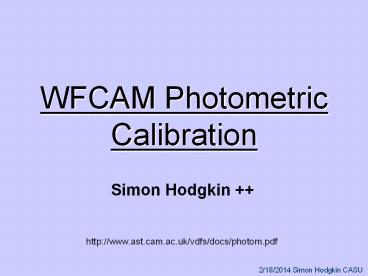WFCAM Photometric Calibration PowerPoint PPT Presentation
Title: WFCAM Photometric Calibration
1
WFCAM Photometric Calibration
- Simon Hodgkin
http//www.ast.cam.ac.uk/vdfs/docs/photom.pdf
2
Overview
- Conversion from WFCAM counts to Vega magnitudes
at airmass unity in the MKO-NIR system - The goal is to achieve this to 2 accuracy
(UKIDSS) - Looking to produce two papers
- (i) modelling of the end-end system
- (ii) empirical measurment of the WFCAM
photometric system - J ZPJ Jinst kJ (? 1)
- strictly kJ kJ kJ(J K)
3
Flies in the ointment
- spatial systematics
- scattered light
- flatfield errors
- variable pixel scale
- geometrical vignetting/secondary reflectivity
- extinction colour dependence
- extinction time dependence
- chip-to-chip gain dependence
- chip-to-chip QE colour effects
- filter colour terms (time variable?)
4
Scattered Light in WFI
WFI V-band observation of a Landolt standard
field. Right hand panel shows the results of
applying a quadratic correction term ?mag
a ( ?2 ?2 )
5
Scattered Light in INT ?
- Landolt field centred on each chip (chip4 twice
offset for clarity) - Plot of distance from rotator centre with size of
bar equal to delta magnitude - No evidence for systematic variation in
delta-magnitude with spatial position. - Note that ESO WFI at CASS with multi-element
corrector, while INT WFC at prime with fewer
reflections
6
WFCAM characterisation plan
- detector noise properties
- microstepping test
- sky emission
- fringing
- sensitivity
- background limit
- cosmic rays
- persistance
- flatfield
- scattered light meso-step field, effect of
bright stars - area calibration chip-chip/channel-channel
- astrometry
- guiding
- photometry set up secondary standard fields
7
Primary Standards
- JAC are observing standards with the Mauna Kea
consortium filter set in UFTI (Simons and
Tokunaga 2002, Tokunaga et al. 2002) - WFCAM uses the same JHK filter system
- gt100 UKIRT standards with (JHK)MKO-NIR which will
not saturate a 1s WFCAM exposure (about 50 for a
5s exp) http//www.jach.hawaii.edu/JACpublic/UKIRT
/astronomy/calib/fs_izjhklm.dat - Preliminary results show persistence effects are
small (2e-4 after 20s) - The UKIRT standards therefore make excellent
primary standards for WFCAM - Y,Z and narrow-band filters require extra work
8
Funny Filters
- YZ define new passbands
- YZ can be bootstrapped into the Vega system
- Requires observations of primary standards over
a wide range of colours to define the ZP - Can then tie secondary fields into the same
system - Narrowband filters (H2, Br-?, CO) require
observations of flux standards first
9
Secondary Standards
- By defining standard fields we
- Beat down the noise
- Allow for variables
- Can measure spatial systematics
- Can measure colour-terms (can change)
- Calibrate 4 detectors simultaneously
- Choose fields
- Spaced every 2 hours in RA
- Equatorial (good for VISTA)
- ?20 degrees (X1.0)
10
Initial Strategy
- Observe UKIRT standards with each chip
- Chip-to-chip gain
- Colour equations
- Meso-step star field across array
- Spatial systematics
- Begin programme to define secondary standards
11
Long Term Strategy
- Repeat measurements of secondary standard fields
(gt3 measurements per field) - Monitor spatial systematics (esp. as WFCAM comes
off/on) - Monitor colour equations
12
Possible standard fields
- Around UKIRT standards
- 100s of stars, measured simul. with primary std
- Mostly red
- Near Galactic Plane (5h4518, 7h1500, 17h5000,
20h3018) - 1000s of stars, avoid worst crowding
- Mostly red
- Globular clusters (NGC5053, M3)
- Horizontal branch for blue stars
- Small, dense cores
- Open clusters (Pleiades, Praesepe)
- Numerous, large areal coverage
- Not many stars
13
NGC5053 2MASS J
8 arcminutes
14
NGC5053 source counts
15
The Globular M3
16
M3 Source Counts
17
Gal Plane 1000 (red) stars
5h45m18d (l190, b-6)
18
Galactic Plane Field
19
The Globular NGC5053
20
standard fields for WFCAM
- fields centred on primary standards from Persson
et al. (1998) and UKIRT FS (Harwarden et al.
2001, Leggett et al. 2003) - equatorial strip overhead (?1) ?20 MKO,
?-25 Paranal - used 2MASS catalogue to select fields with gt100
stars per chip (to J16) - 64 equatorial, 13 northern, 12 southern
- further refinement required
21
WFCAM/VISTA Standard fields
22
Pre-WFCAM observations?
- How photometrically stable is MKO, e.g. with
humidity? - How does extinction vary with time on a wet vs
dry night? - Enough data to investigate this?
23
UFTI standards
- data span Jan 2000 to Oct 2003
- only selected nights with gt4 stds in each of
J,H,K - delta AM gt0.5
24
Humidity
25
How many standards?
26
Nightly Calibration
- We must measure enough standards every night to
ensure that the photometricity of a (fraction of
a) night can be derived from the data. - Overheads
- E.g. ( (3x5s) 20s ) x 5 filters slew acq
- 5s S/N100 J15 (5 min total)
- 30s S/N100 J16 (11min total)
- Frequency
- Hourly - this will not be under the observers
control - Extinction
- Do we measure it nightly/hourly/at all ?

